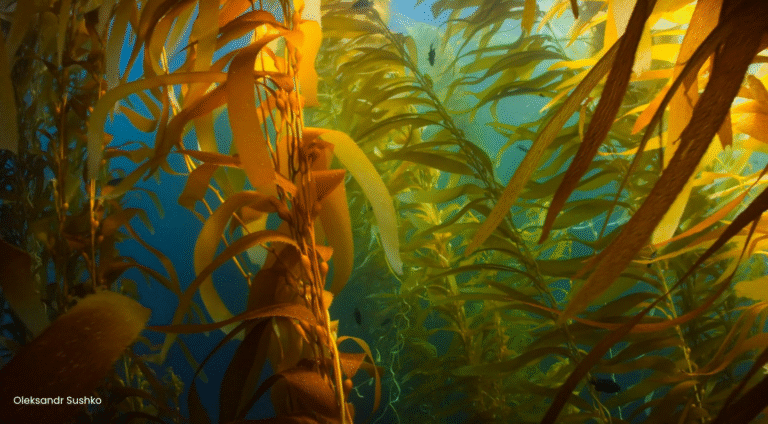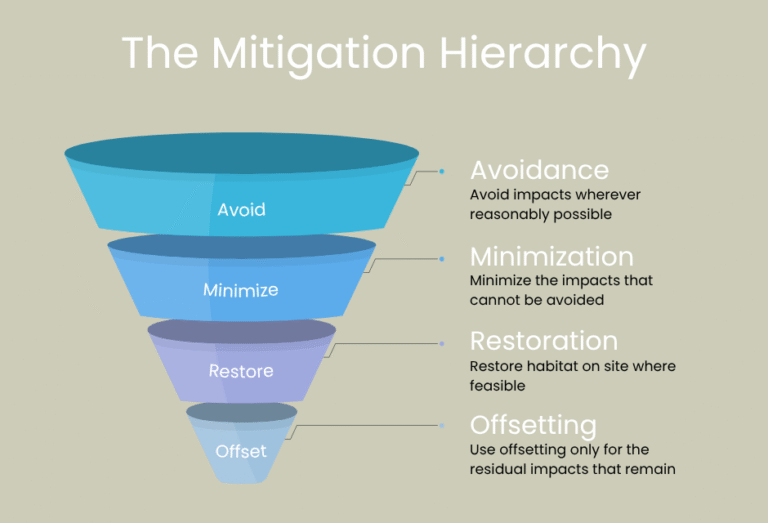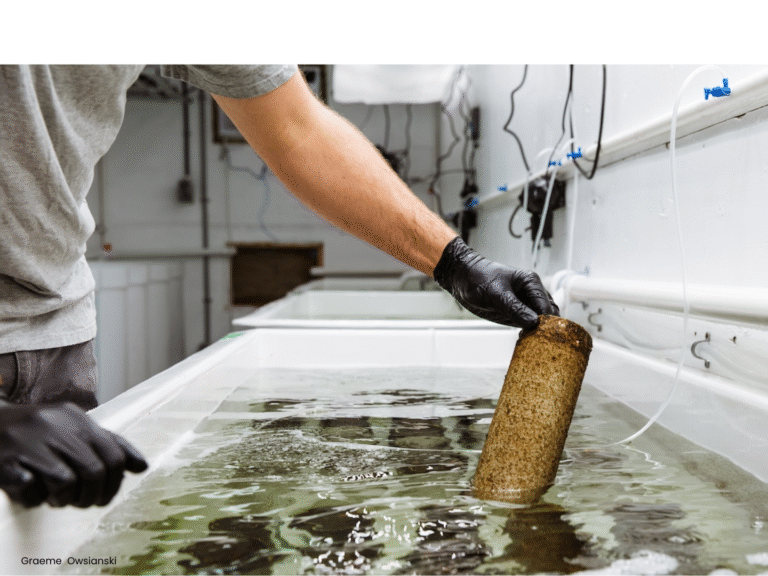Integrating Kelp Cultivation into Canada's habitat offsetting framework
TLDR
Kelp forests create critical habitat, but they are declining globally, including along the coast of British Columbia. Habitat offsetting is the practice of restoring or creating habitat to counterbalance unavoidable damage to fish habitat under laws such as the Fisheries Act.
Kelp restoration can serve as a high-integrity marine offset when it’s local, like-for-like, methodically monitored, and embedded in an adaptive management plan. West Coast Kelp cultivates and outplants kelp at scale and works with environmental consultants to design and deliver kelp-based offsets.
Kelp forests, their decline, and the restoration movement
Kelp forests are critical habitat
Around the world, kelp forests are declining, creating a global movement to protect and restore these ecosystems. This movement is built on a growing recognition of how much healthy kelp forests do for coastal waters.
Kelp forests create three-dimensional structure that supports biodiversity by offering shelter, foraging habitat, and attachment surfaces for a wide range of marine organisms. Beyond biodiversity, kelp forests support broader ecosystem services, from coastal productivity and nutrient cycling to cultural and recreational values.

The emerging kelp sector in British Columbia
British Columbia has seen big developments in efforts to restore kelp forests, and establish a regenerative seaweed mariculture industry. As a result, a young, growing sector has established. This sector has great players that are building the infrastructure to cultivate kelp at large scales.
Since being founded in 2022, West Coast Kelp has cultivated over 25 tons of kelp biomass for restoration and mariculture projects. This production has supported the outplanting of over 30,000 kelps and more than 7 habitat restoration projects.
Habitat offsetting under the Fisheries Act and where kelp fits
Why offsetting exists in Canada
Under the Fisheries Act, activities that result in harmful impacts to fish and fish habitat are regulated and generally avoided wherever possible. In some projects, however, some residual effects are still expected even after mitigation. This is where offsetting comes in. When a project will cause residual effects on fish habitat even after mitigation, regulators expect a plan to counterbalance those impacts through habitat offsetting.
Habitat offsetting as the last step in the mitigation hierarchy
Habitat Offsetting is a last-resort step in the mitigation hierarchy, after avoidance and minimization used to counterbalance residual impacts to biodiversity from development.
In practice, that means:
- Avoid impacts wherever reasonably possible.
- Minimize the impacts that cannot be avoided.
- Restore or rehabilitate habitat on site where feasible.
- Use offsetting only for the residual impacts that remain.
Offsets are not a licence to impact habitat that could have been avoided. They are a tool for dealing with what is left over after mitigation has been taken as far as is reasonably practicable.

What the Department of Fisheries and Oceans looks for in offset plans
The Department of Fisheries and Oceans (DFO) places strong emphasis on restoring degraded habitat and generally expects clear plans that show ecological equivalency and measurable outcomes.
For marine and coastal projects, that typically includes:
- Showing how the offset habitat is comparable to what is being impacted.
- Defining measurable indicators that can be tracked over time.
- Committing to monitoring and adaptive management, not just a one-time planting event.
Kelp-based projects need to fit into this same frame. They are one possible way to restore degraded nearshore habitat where kelp forests are part of the affected ecosystem.
Why kelp forests are a fit for marine habitat offsetting
Kelp forests as habitat, not just biomass
Kelp forests aren’t just “plants in the water.” They create complex habitat that the ecosystem relies on. When you restore kelp, you’re restoring ecosystem services that supports wildlife and coastal communities.
Alignment with ecological equivalency
When the impact occurs in nearshore marine systems where kelp would naturally occur, kelp restoration can contribute to ecological equivalency. In these cases, restoring kelp helps replace lost or degraded habitat in a comparable ecological setting, aligning with DFO’s emphasis on restoring degraded habitat and tracking measurable outcomes.
What a high-integrity kelp habitat offset looks like
Local and like-for-like design
High-integrity kelp offsets start with where you put them and what you are trying to replace. Two basic checks help at the design stage:
- Local: offset sites are in the same general region and ecological context as the impact.
- Like-for-like: you’re creating kelp habitat where kelp habitat has been lost or degraded, or in a clearly comparable nearshore system.
Robust field protocols and monitoring
Expectations on the monitoring side typically include:
- Defined indicators such as kelp density, canopy extent, and associated species presence.
- A monitoring schedule that tracks change through time, not just a single post-installation survey.
- Reporting that ties results back to the original offset objectives.
Adaptive management and measurable outcomes
Monitoring results should feed back into project decisions. If targets are not being met, the plan needs room for adjustments to methods, effort, or timelines. This adaptive management approach helps ensure offsets move toward ecological outcomes that can be defended in front of regulators and third parties.

How West Coast Kelp delivers kelp-based habitat creation
Kelp cultivation at scale
West Coast Kelp cultivates kelp at scale to create habitat structure and biomass for restoration and mariculture projects. That includes nursery production, growing kelp to field-ready stages, and conducting outplanting in coastal environments.

Reducing execution risk for consultants
For environmental consultants, the key risk is promising offsets that are hard to deliver on time and at the required scale. Partnering with West Coast Kelp on kelp cultivation and outplanting lowers that risk by bringing in a team that already runs nursery and field operations for kelp at scale.
WCK’s role is to handle the kelp cultivation and practical deployment so that consultants can focus on designing offset plans that are technically sound, aligned with regulatory expectations, and implementable on realistic project timelines.
Pathways to integrate kelp into your offset strategy
Direct project-linked offsets
One straightforward pathway is to design kelp restoration as a project-specific offset linked to a particular development impact. In this model, the offset is tailored to the project footprint and sits in the same region and ecological context.
West Coast Kelp can support by:
- Producing kelp seed and biomass for deployment.
- Assisting with field installation and logistics.
- Supporting monitoring design and implementation as part of the broader offset plan.
Kelp restoration in habitat banking
In some contexts, proponents may be able to use habitat banking to generate advance offset credits, provided projects meet the same ecological standards and verification requirements.
Kelp restoration projects can be structured to contribute to this kind of banked inventory where the regulatory framework allows it, creating options for future marine projects that need kelp or nearshore habitat offsets.
Practical considerations at early scoping
When you are scoping a project that may need marine offsets, kelp is worth considering early if:
- The impact is in or near suitable kelp habitat.
- There is enough lead time to plan and implement cultivation and deployment.
- Monitoring and adaptive management requirements can be built into the project budget and schedule.
Next steps if you want to explore kelp-based offsets with West Coast Kelp
If you’re working on a marine or coastal project and want to explore how kelp cultivation and restoration could support your habitat offsetting requirements, book a meeting with us to talk through your project and explore what’s feasible.
